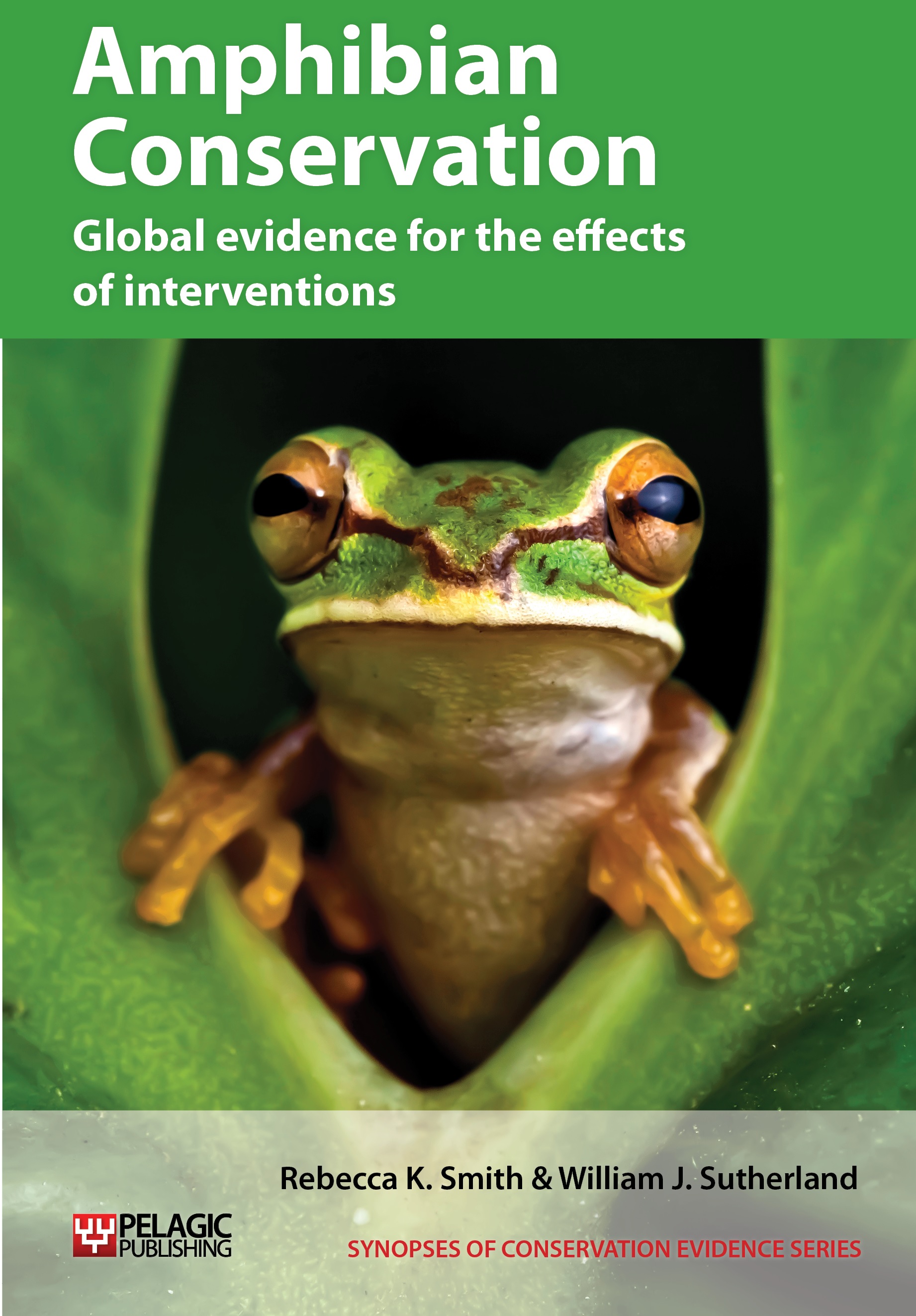Thin trees within forests
-
Overall effectiveness category Likely to be ineffective or harmful
-
Number of studies: 9
View assessment score
Hide assessment score
How is the evidence assessed?
-
Effectiveness
35% -
Certainty
60% -
Harms
40%
Study locations
Supporting evidence from individual studies
A site comparison study in 2000–2002 of 10 sites within a conifer-hardwood forest in California, USA (Karraker & Welsh 2006) found that thinning increased amphibian abundance, apart from ensatinas Ensatina eschscholtzii, and lowered the body condition of ensatinas, ten years after harvest. Overall, captures were significantly higher in thinned (7/1000 capture nights) compared to unthinned (4) and clearcut forest (4). However, abundance of the dominant species, ensatina, was similar in thinned (148 captures), unthinned (106) and clearcut forests (159). The body condition index of ensatinas was significantly lower in thinned compared to unthinned forests. Five thinned (aged > 10 years) and five unharvested forest stands adjacent to clearcuts (aged 6–25 years) were selected. Forest had been thinned (approximately 50% retained) prior to clearcutting. Amphibians were monitored using seven drift-fences with pitfall traps and artificial coverboards along two 150 m transects/site. Traps were checked weekly in October–December and April–June 2000–2002.
Study and other actions testedA randomized, replicated, controlled study in 2004–2005 of mixed coniferous and deciduous forest wetlands in Maine, USA (Patrick, Hunter & Calhoun 2006) found that amphibian abundance in partial (50%) harvest plots tended to be lower than unharvested and higher or similar to clearcuts (see also Popescu et al. 2012). The proportion of captures in partial harvest was lower than that in unharvested plots for adults and/or juveniles of eight of nine species including adult wood frogs Lithobates sylvaticus (partial: 27%; unharvested: 51%; clearcut: 11%) and juvenile spotted salamanders Ambystoma maculatum (partial: 20%; unharvested: 62%; clearcuts: 7–11%). Captures were higher in partial harvests than unharvested plots for adult northern leopard frogs Lithobates pipiens (partial: 47%; unharvested: 30%; clearcuts: 7–17%) and red-spotted newts (partial: 44%; unharvested: 25%). Captures in partial harvest were higher than clearcuts for adults of four of nine species, lower for two species and similar for three species. Juvenile captures were higher in partial harvests than clearcuts for seven of nine species. All treatments extended 164 m (2 ha) from each of four created breeding ponds and were cut in 2003–2004. There were two clearcut treatments with and without woody debris retained. Drift-fences with pitfall traps were installed around each pond at 1, 17, 50, 100 and 150 m from the edge. Monitoring was in April–September 2004–2005.
Study and other actions testedA replicated, site comparison study in 2000–2003 of 12 harvested hardwood forest sites in Maine, USA (Perkins, Malcolm & Hunter 2006) found that abundance of amphibian species in partially harvested forest was similar or lower than unharvested forest and similar or higher than clearcut forest. Captures in partial harvests were significantly lower than unharvested forest and higher than clearcuts for red-backed salamanders Plethodon cinereus (partial: 0.38; clearcut: 0.12; unharvested: 0.61/100 trap nights) and spotted salamanders Ambystoma maculatum (partial: 0.03; clearcut: 0.01; unharvested: 0.09). There was no significant difference between treatments for two-lined salamanders Eurycea bislineata (partial: 0.12; clearcut: 0.04; unharvested: 0.16), American toads Bufo americanus (partial: 1.01; clearcut: 0.49; unharvested: 0.34) or wood frogs Rana sylvatica (partial: 0.99; clearcut: 0.92; unharvested: 1.54). Twelve headwater streams that had been harvested 4–10 years previously were selected. Treatments were: partial harvest (23–53% removed), clearcut with 23–35 m buffers and unharvested for > 50 years. Monitoring was undertaken in June–September in one year using drift-fences with pitfall traps and visual surveys.
Study and other actions testedA controlled, before-and-after site comparison study in 1998–2001 at two largely coniferous forest sites in western Oregon, USA (Rundio & Olson 2007) found that the amount of pre-existing downed wood affected the response of salamanders to forest thinning. At the site with high volumes of existing downed wood, there was no significant change in capture rates of the dominant species ensatina Ensatina eschscholtzii or Oregon slender salamander Batrachoseps wrighti following thinning. However, at the site with little downed wood, capture rates declined significantly for the two dominant species, ensatina (40%) and western red-backed salamanders Plethodon vehiculum (42%). Captures did not change in unharvested treatments. At the two sites, treatments were unharvested or thinned (80% thinned to 200–240 trees/ha; 10% harvested in groups; 10% patches retained; deadwood was retained) with riparian buffers (6 to ≥70 m). Monitoring was undertaken in May–June before and two years after thinning. Visual count surveys were along 64–142 m transects perpendicular to each stream bank (7–8/treatment).
Study and other actions testedA replicated, site comparison study in 2005 of three coniferous forest sites in Oregon, USA (Kluber, Olson & Puettmann 2008) found that there was no significant difference between amphibian captures in thinned and unharvested sites 5–6 years after harvest. Captures did not differ significantly between treatments for all amphibians, western red-backed salamanders Plethodon vehiculum or ensatina Ensatina eschscholtzii. Each site (12–24 ha) had two streams within forest that had been thinned (200–600 trees/ha) with riparian buffers (6 m or over 15 m wide) in 2000 and one stream with no harvesting. Amphibians were sampled by visual counts once in April–June within five 5 x 10 m plots at four distances (up to 35 m) from each stream.
Study and other actions testedA replicated, controlled study in 2003–2009 of 12 ponds in deciduous, pine and mixed-deciduous and coniferous forest in Maine, Missouri and South Carolina, USA (Semlitsch et al. 2009) found that overall, partially harvesting forest had a negative effect on amphibian population, physiological and behavioural responses, but a smaller negative effect than clearcutting (−7 vs −19 to 32%). Sixteen of 34 response variables were negative, 10 positive and eight the same as unharvested forest. Four treatments were assigned to quadrats (2–4 ha) around each breeding pond (4/region): partial harvest (opposite control; 50–60% reduction), clearcut with coarse woody debris retained or removed and unharvested. Treatments were applied in 2003–2005. Monitoring was undertaken using drift-fence and pitfall traps, radiotelemetry and aquatic (200–1,000 Litres) and terrestrial (3 x 3 m or 0.2 m diameter) enclosures. Different species (n = 9) were studied at each of the eight sites. Response variables were abundance, growth, size, survival, breeding success, water loss, emigration and distance moved.
Study and other actions testedA randomized, replicated, controlled study in 2004–2007 of four seasonal wetlands in pine forest in southeastern USA (Todd et al. 2009) found that migrating amphibians tended to use thinned forest a similar amount to unharvested forest and that emigrating salamanders, but not frogs, used it more than clearcuts. Proportions of immigrating amphibians and emigrating frogs did not differ between treatments. The proportion of salamanders combined Ambystoma spp. and mole salamanders Ambystoma talpoideum that emigrated through thinned forest (0.2–0.4) was similar to unharvested forest (0.4–0.5) but significantly higher than clearcuts (0.1–0.2). Significantly higher numbers of ornate chorus frogs Pseudacris ornata emigrated through partial harvests than unharvested forest. Significantly more emigrating salamanders, frogs Rana spp. and southern toads retreated from clearcuts compared to partial harvests and unharvested sites. There were four wetland sites each surrounded by four randomly assigned treatments extending out 168 m (4 ha): thinning (15% removed), clearcut with or without coarse woody debris retained and unharvested. Harvesting was undertaken in spring 2004. Amphibians were captured using drift-fencing with pitfall traps from February 2004 to July 2007.
Study and other actions testedIn a continuation of a previous study (Patrick, Hunter & Calhoun 2006), a randomized, replicated, controlled study in 2004–2009 of mixed forest wetlands in Maine, USA (Popescu et al. 2012) found that amphibian abundance in partially (50%) harvested forest was similar to unharvested forest for six of eight amphibian species and significantly lower for two species. Post-breeding, there were significant differences between partial, clearcut and unharvested treatments for wood frog Lithobates sylvaticus adults (partial: 0.4; unharvested: 0.5; clearcuts: 0.2) and juveniles (partial: 1.1; unharvested: 1.5; clearcuts: 0.9) and spotted salamander Ambystoma maculatum juveniles (partial: 0.4; unharvested: 0.6; clearcuts: 0.2). Abundances during other times of year did not differ significantly for those two species. Post-breeding, partial harvest was used significantly more than clearcuts by the other two forest specialists, eastern red-spotted newts Notophthalmus viridescens (partial: 0.10; clearcuts: 0.06–0.08; unharvested: 0.13), red-backed salamanders Plethodon cinereus (partial: 0.2; unharvested: 0.2; clearcuts: 0.1). Abundance of four habitat generalist species did not differ between treatments. All treatments extended 164 m (2 ha) from each of four created breeding ponds and were harvested in 2003–2004. Drift-fences with pitfall traps were installed around each pond at 2, 17, 50, 100 and 150 m from the edge. Monitoring was in April–September 2004–2009.
Study and other actions testedA meta-analysis of the effects of different harvest practices on terrestrial salamanders in North America (Tilghman, Ramee & Marsh 2012) found that partial harvest, including thinning, cutting individual or groups of trees and shelterwood harvesting, decreased salamander populations, but less so than clearcutting. Reductions in populations were lower following partial harvest (all studies: 31–48%; < 5 years monitoring: 51%; > 10 years monitoring: 29%) compared to clearcutting (all: 54–58%; < 5 years: 62%; > 10 years: 50%). There was no significant effect of the proportion of canopy removed in partial harvests. Sampling methodology influenced perceived effects of harvest. Salamander numbers almost always declined following timber removal, but populations were never lost and tended to increase as forests regenerated. Studies that compared salamander abundance in harvested (partial or clearcut) and unharvested areas were identified. Twenty-four site comparison and before-and-after studies were analysed. Abundance measures included counts, population indices and density estimates.
Study and other actions tested
Where has this evidence come from?
List of journals searched by synopsis
All the journals searched for all synopses
This Action forms part of the Action Synopsis:
Amphibian Conservation
Amphibian Conservation - Published 2014
Amphibian Synopsis





)_2023.JPG)














